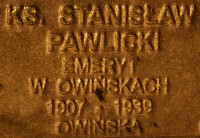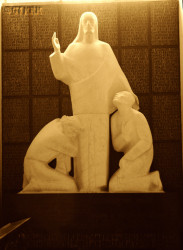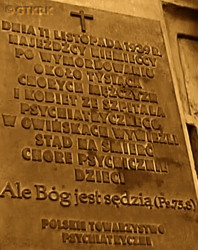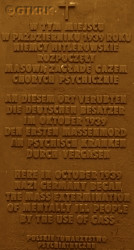Roman Catholic
St Sigismund parish
05-507 Słomczyn
85 Wiślana Str.
Konstancin deanery
Warsaw archdiocese, Poland
full list:
displayClick to display full list

searchClick to search full list by categories
wyświetlKliknij by wyświetlić pełną listę po polsku

szukajKliknij by przeszukać listę wg kategorii po polsku

Martyrology of the clergy — Poland
XX century (1914 – 1989)
personal data

surname
PAWLICKI
forename(s)
Stanislav (pl. Stanisław)
function
diocesan priest
creed
Latin (Roman Catholic) Church RCmore on
en.wikipedia.org
[access: 2014.09.21]
diocese / province
Gniezno and Poznań archdiocese (aeque principaliter)more on
www.archpoznan.pl
[access: 2012.11.23]
date and place
of death
10.1939

Owińskatoday: Czerwonak gm., Poznań pov., Greater Poland voiv., Poland
more on
en.wikipedia.org
[access: 2021.07.29]
alt. dates and places
of death
11.1939
KL Posenconcentration camp
today: Poznań, Poznań city pov., Greater Poland voiv., Poland
more on
en.wikipedia.org
[access: 2022.01.09]
Rożnowotoday: Oborniki gm., Oborniki pov., Greater Poland voiv., Poland
more on
en.wikipedia.org
[access: 2021.12.18]
details of death
After German and Russian invasion of Poland in 09.1939 and start of the World War II, after start of German occupation, murdered (in a gas chamber?) by the Germans in forests by the psychiatric hospital in Owińska, together with all institute's patients, as part of the genocidal program «Aktion T4».
alt. details of death
According to some latest sources some of the Owińska patients were gassed by the Germans in special cars with carbon monoxide in KL Posen (Fort VII) concentration camp, and some murdered in the forests to the north of Oborniki Wielkopolskie (c. 30 km from Owińska).
cause of death
mass murder
perpetrators
Germans
sites and events
KL PosenClick to display the description, OwińskaClick to display the description, «Aktion T4»Click to display the description, Ribbentrop‐MolotovClick to display the description, Pius XI's encyclicalsClick to display the description
date and place
of birth
1907

presbyter (holy orders)
ordination
14.06.1931

Poznańtoday: Poznań city pov., Greater Poland voiv., Poland
more on
en.wikipedia.org
[access: 2021.07.18]
St Peter and St Paul the Apostles RC archcathedral churchmore on
en.wikipedia.org
[access: 2025.03.14]
positions held
till 1939
patient — Owińskatoday: Czerwonak gm., Poznań pov., Greater Poland voiv., Poland
more on
en.wikipedia.org
[access: 2021.07.29] ⋄ Voivodeship's Psychiatric Institute
c. 1936 – c. 1938
pensioner — Krotoszyntoday: Krotoszyn gm., Krotoszyn pov., Greater Poland voiv., Poland
more on
en.wikipedia.org
[access: 2021.07.18] ⋄ Congregation's house, St Elizabeth Sisters CSSE — prob.
1932 – c. 1934
vicar — Poznańtoday: Poznań city pov., Greater Poland voiv., Poland
more on
en.wikipedia.org
[access: 2021.07.18] ⋄ St Martin the Bishop and Confessor RC parish ⋄ Poznańtoday: Poznań city pov., Greater Poland voiv., Poland
more on
en.wikipedia.org
[access: 2021.07.18] RC deanery
1931 – 1932
vicar — Poznańtoday: Poznań city pov., Greater Poland voiv., Poland
more on
en.wikipedia.org
[access: 2021.07.18] ⋄ Blessed Virgin Mary Immaculate Conception RC parish ⋄ Poznańtoday: Poznań city pov., Greater Poland voiv., Poland
more on
en.wikipedia.org
[access: 2021.07.18] RC deanery
till 1931
student — Poznańtoday: Poznań city pov., Greater Poland voiv., Poland
more on
en.wikipedia.org
[access: 2021.07.18] ⋄ philosophy and theology, Archbishop's Theological Seminary (Collegium Leoninum)
others related
in death
GROCHOWALSKAClick to display biography Angela (Sr Marciana), KLUPSCHClick to display biography George, LUDWIKOWSKIClick to display biography Peter, MARCINIAKClick to display biography Marianne, SKROBACKAClick to display biography Wanda (Sr Josefa of Sweet Heart of Jesus), WALTERClick to display biography Pelagia (Sr Julitta)
sites and events
descriptions
KL Posen: German Posen — Fort VII — camp founded in c. 10.10.1939 in Poznań till mid of 11.1939 operated formally as Germ. Konzentrationslager (Eng. concentration camp) KL Posen, and this term is used throughout the White Book, also later periods. It was first such a concentration camp set up by the Germans on Polish territory — in case of Greater Poland (Wielkopolska) directly incorporated into German Reich. In 10.1939 in KL Posen for the first time Germans used gas to murder civilian population, in particular patients of local psychiatric hospitals. From 11.1939 the camp operated as German political police Gestapo prison and transit camp (Germ. Übergangslager), prior to sending off to concentration camps, such as KL Dachau or KL Auschwitz. In 28.05.1941 the camp was rebranded as police jail and slave labour corrective camp (Germ. Arbeitserziehungslager). At its peak up to 7‐9 executions were carried in the camp per day, there were mass hangings of the prisoners and some of them were led out to be murdered elsewhere, outside of the camp. Altogether in KL Posen Germans exterminated approx. 20,000 inhabitants of Greater Poland (Wielkopolska) region, including many representatives of Polish intelligentsia, patients and staff of psychiatric hospitals and dozen or so Polish priests. Hundreds of priests were held there temporarily prior to transport to other concentration camps, mainly KL Dachau. From 03.1943 the camp had been transformed into an industrial complex (from 25.04.1944 — Telefunken factory manufacturing radios for submarines and aircrafts). (more on: www.wmn.poznan.plClick to attempt to display webpage
[access: 2019.02.02], en.wikipedia.orgClick to attempt to display webpage
[access: 2013.12.27])
Owińska: In 1939 Germans — as part of «Aktion T4» — murdered all patients from the institute‐hospital for mentally ill in Owińska n. Poznań. Some of them (mainly adults, men and women) were murdered in Rożnowo Forests north of Oborniki Wielkopolskie, c. 30 km from Owińska (Germans murdered there c. 12.000 Poles, including c. 900‐1,000 patients from Owińska institute). After being brought to the place of execution the victims were loaded into a special trucks converted to gas chambers, made in the workshops of the German political police Gestapo in Poznań. Others (mainly children) were murdered in KL Posen (Fort VII) concentration camp, in gas chambers — altogether approx. 1,000 patients perished. In KL Posen concentration camp Owińska patients were prob. gassed by the Germans with carbon monoxide in cylinders, in a bunker with all openings and iron gates sealed with clay. This was supposedly the first case of gas usage for mass murder of civilian population. (more on: pl.wikipedia.orgClick to attempt to display webpage
[access: 2012.11.23], pl.wikipedia.orgClick to attempt to display webpage
[access: 2012.12.28])
«Aktion T4»: German state euthanasia program, systematic murder of people mentally retarded, chronically, mentally and neurologically ill — „elimination of live not worth living” (Germ. „Vernichtung von lebensunwertem Leben”). At a peak, in 1940‐1941, c. 70,000 people were murdered, including patients of psychiatric hospitals in German occupied Poland — German formalists noted then that, among others, „performing disinfection [i.e. gassing] of 70,273 people with a life expectancy of up to 10 years saved food in the amount of 141,775,573.80 Deutschmark”. From 04.1941 also mentally ill and „disabled” (i.e. unable to work) prisoners held in German concentration camps were included in the program — denoted then as «Aktion 14 f 13». C. 20,000 inmates were then murdered, including Polish Catholic priests held in KL Dachau concentration camp, who were murdered in Hartheim gas chambers. The other „regional extension” of «Aktion T4» was «Aktion Brandt» program during which Germans murdered chronically ill patients in order to make space for wounded soldiers. It is estimated that at least 30,000 were murdered in this program. (more on: en.wikipedia.orgClick to attempt to display webpage
[access: 2014.10.31])
Ribbentrop‐Molotov: Genocidal Russian‐German alliance pact between Russian leader Joseph Stalin and German leader Adolf Hitler signed on 23.08.1939 in Moscow by respective foreign ministers, Mr. Vyacheslav Molotov for Russia and Joachim von Ribbentrop for Germany. The pact sanctioned and was the direct cause of joint Russian and German invasion of Poland and the outbreak of the World War II in 09.1939. In a political sense, the pact was an attempt to restore the status quo ante before 1914, with one exception, namely the „commercial” exchange of the so‐called „Kingdom of Poland”, which in 1914 was part of the Russian Empire, fore Eastern Galicia (today's western Ukraine), in 1914 belonging to the Austro‐Hungarian Empire. Galicia, including Lviv, was to be taken over by the Russians, the „Kingdom of Poland” — under the name of the General Governorate — Germany. The resultant „war was one of the greatest calamities and dramas of humanity in history, for two atheistic and anti‐Christian ideologies — national and international socialism — rejected God and His fifth Decalogue commandment: Thou shall not kill!” (Abp Stanislav Gądecki, 01.09.2019). The decisions taken — backed up by the betrayal of the formal allies of Poland, France and Germany, which on 12.09.1939, at a joint conference in Abbeville, decided not to provide aid to attacked Poland and not to take military action against Germany (a clear breach of treaty obligations with Poland) — were on 28.09.1939 slightly altered and made more precise when a treaty on „German‐Russian boundaries and friendship” was agreed by the same murderous signatories. One of its findings was establishment of spheres of influence in Central and Eastern Europe and in consequence IV partition of Poland. In one of its secret annexes agreed, that: „the Signatories will not tolerate on its respective territories any Polish propaganda that affects the territory of the other Side. On their respective territories they will suppress all such propaganda and inform each other of the measures taken to accomplish it”. The agreements resulted in a series of meeting between two genocidal organization representing both sides — German Gestapo and Russian NKVD when coordination of efforts to exterminate Polish intelligentsia and Polish leading classes (in Germany called «Intelligenzaktion», in Russia took the form of Katyń massacres) where discussed. Resulted in deaths of hundreds of thousands of Polish intelligentsia, including thousands of priests presented here, and tens of millions of ordinary people,. The results of this Russian‐German pact lasted till 1989 and are still in evidence even today. (more on: en.wikipedia.orgClick to attempt to display webpage
[access: 2015.09.30])
Pius XI's encyclicals: Facing the creation of two totalitarian systems in Europe, which seemed to compete with each other, though there were more similarities than contradictions between them, Pope Pius XI issued in 03.1937 (within 5 days) two encyclicals. In the „Mit brennender Sorge” (Eng. „With Burning Concern”) published on 14.03.1938, condemned the national socialism prevailing in Germany. The Pope wrote: „Whoever, following the old Germanic‐pre‐Christian beliefs, puts various impersonal fate in the place of a personal God, denies the wisdom of God and Providence […], whoever exalts earthly values: race or nation, or state, or state system, representatives of state power or other fundamental values of human society, […] and makes them the highest standard of all values, including religious ones, and idolizes them, this one […] is far from true faith in God and from a worldview corresponding to such faith”. On 19.03.1937, published „Divini Redemptoris” (Eng. „Divine Redeemer”), in which criticized Russian communism, dialectical materialism and the class struggle theory. The Pope wrote: „Communism deprives man of freedom, and therefore the spiritual basis of all life norms. It deprives the human person of all his dignity and any moral support with which he could resist the onslaught of blind passions […] This is the new gospel that Bolshevik and godless communism preaches as a message of salvation and redemption of humanity”… Pius XI demanded that the established human law be subjected to the natural law of God , recommended the implementation of the ideal of a Christian state and society, and called on Catholics to resist. Two years later, National Socialist Germany and Communist Russia came together and started World War II. (more on: www.vatican.vaClick to attempt to display webpage
[access: 2023.05.28], www.vatican.vaClick to attempt to display webpage
[access: 2023.05.28])
sources
personal:
www.wtg-gniazdo.orgClick to attempt to display webpage
[access: 2012.11.23], wtkplay.plClick to attempt to display webpage
[access: 2016.03.14]
original images:
wtkplay.plClick to attempt to display webpage
[access: 2016.03.14], wtkplay.plClick to attempt to display webpage
[access: 2016.03.14]
LETTER to CUSTODIAN/ADMINISTRATOR
If you have an Email client on your communicator/computer — such as Mozilla Thunderbird, Windows Mail or Microsoft Outlook, described at WikipediaPatrz:
en.wikipedia.org, among others — try the link below, please:
LETTER to CUSTODIAN/ADMINISTRATORClick and try to call your own Email client
If however you do not run such a client or the above link is not active please send an email to the Custodian/Administrator using your account — in your customary email/correspondence engine — at the following address:

giving the following as the subject:
MARTYROLOGY: PAWLICKI Stanislav
To return to the biography press below:
 Click to return to biography
Click to return to biography














